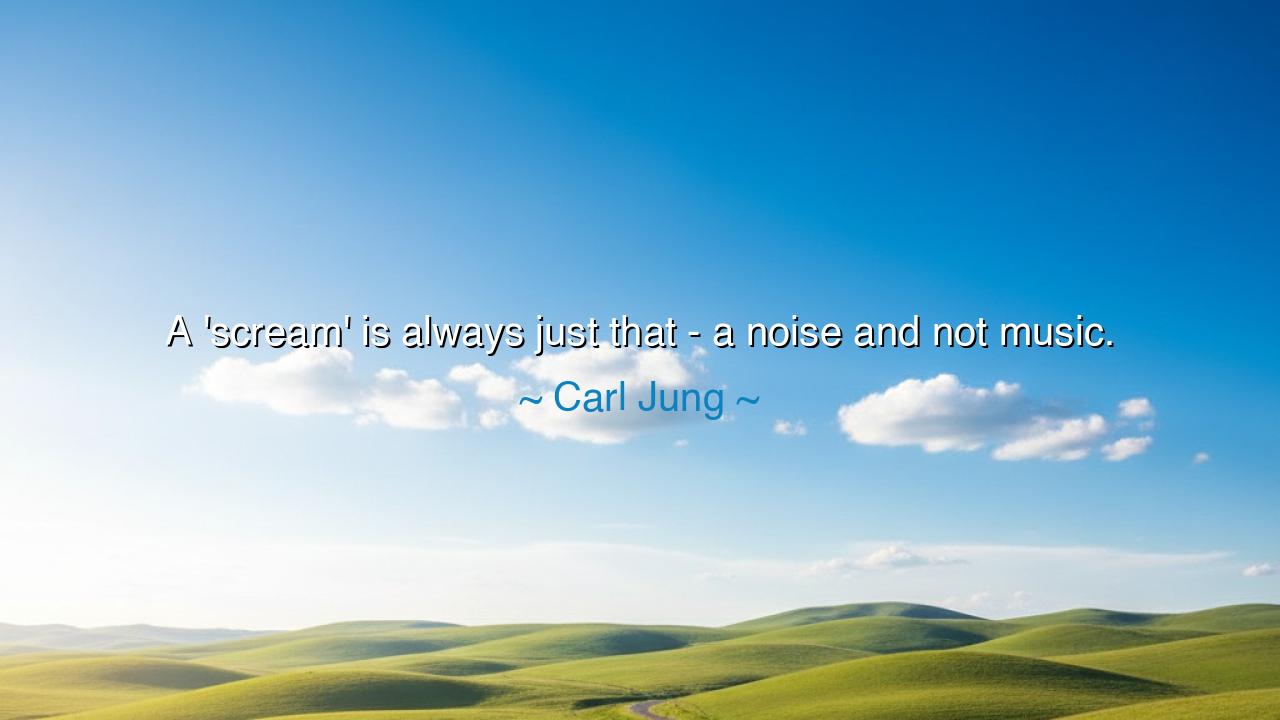
A 'scream' is always just that - a noise and not music.






Carl Jung, the great explorer of the human soul, once proclaimed: “A ‘scream’ is always just that—a noise and not music.” In this saying, he casts light upon the eternal struggle between chaos and order, between the unshaped cry of raw emotion and the disciplined harmony that transforms passion into beauty. A scream may erupt from the depths of anguish or rage, but it is not yet music—for music is the ordering of sound, the shaping of feeling into form, the transformation of chaos into creation.
The ancients knew this truth well. The Greeks spoke of Dionysus, god of frenzy and wild ecstasy, and of Apollo, god of reason and structure. Both forces existed within mankind, but it was Apollo who gave form to Dionysus’ madness, turning the wild cry into poetry, the frenzied dance into art. In Jung’s words, the scream belongs to Dionysus—raw, uncontrolled, unshaped. Music, however, is the Apollonian act of discipline, where raw energy is transformed into something that can endure, something that uplifts rather than merely erupts.
Consider the tale of Edvard Munch’s painting The Scream. It captures the terror and despair of modern man, a silent figure whose mouth is stretched wide in voiceless agony. The painting has power—it shocks, it unsettles—but it does not soothe, nor guide, nor uplift. It is the perfect representation of Jung’s thought: the scream is pure noise, capable of expression but not of transformation. It is the raw material of the psyche, but not yet the music that heals or transcends.
History also gives us Beethoven. Deaf and filled with inner torment, he could have chosen to scream into the void of his suffering. Yet instead, he transformed his anguish into symphonies. His Ninth is not a scream of despair but a hymn to joy, a song that embraces all of humanity. Here is the difference Jung teaches: the scream is raw noise, born of emotion. But when harnessed, shaped, and ordered, it becomes music, capable of enduring through centuries, capable of moving the hearts of millions.
The wisdom of this quote also points inward, to the human heart. All of us carry screams within us—of anger, of grief, of fear. To let them loose without form is natural, but not fruitful. To live only in screams is to live in chaos. But to take that inner cry and shape it—to write, to sing, to build, to love—this is to turn noise into music, despair into beauty, chaos into creation. Jung urges us not to remain in the scream, but to rise into the harmony of the song.
The lesson, then, is this: do not mistake raw outburst for true expression. A scream may reveal your pain, but it does not transform it. If you would grow, if you would heal, if you would create, you must discipline your chaos and give it form. The scream must be the beginning, not the end. Music is born when the scream is tamed by spirit, when passion is joined to purpose, when feeling is given structure.
Practical wisdom follows: when overwhelmed, let yourself feel the scream within, but do not stop there. Channel it. Write your grief in words that can be read. Sing your sorrow in tones that can be shared. Pour your anger into action that builds, not destroys. Take the rawness of your heart and give it form, that it may serve not only you but others. For in doing so, you fulfill Jung’s wisdom: you turn noise into music.
So remember Carl Jung’s words: “A ‘scream’ is always just that—a noise and not music.” Carry them as a guiding star. Let your pain be a spark, but not the whole fire. Let your cries be the seed, but not the final harvest. Transform the unshaped into the shaped, the fleeting into the enduring. In this, you will live not as one lost in noise, but as one whose very life becomes a song.






AAdministratorAdministrator
Welcome, honored guests. Please leave a comment, we will respond soon